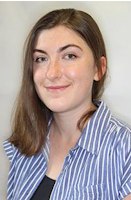Learn about Madeline Honig's dissertation work!
Chemistry graduate student Madeline Honig is developing a new theory to describe and optimize the behavior of electrochemical sensors to monitor ion concentrations with wearable and implantable sensors. The theory has implications for the medical field, as well as for industrial process control.Honig’s dissertation work is focused on advancing electroanalytical sensors through fundamental research into sensor function and novel sensor design. Ion-selective electrodes (ISEs) with polymeric, receptor-doped sensing membranes use electrical voltages to monitor the concentrations of biologically active ions in the body.
ISEs have been used for half a century in hospital laboratory clinical analyzers to measurement billions of samples. However, applications at the point of care as well as wearable and implantable sensing have only emerged recently and leave a number of challenges to be addressed.
In particular, for sensing applications in the medical field, the limits of detection for certain ions can be limited by interfering ions of low hydration energy, such as thiocyanate in the blood of smokers and salicylate in the blood of patients who have taken headache pills.
Honig is working to solve this issue by establishing selectivity coefficients for hydrophobic ions with a charge sign opposite to that of the ISEs’ target ions. With a number of iterations through several decades, the selectivities of ISEs for interfering ions with the same charge sign as the target ion have been explained as a function of the sensing membrane composition.
However, by addressing ions of the opposite charge sign, she is entering completely unchartered territory. Early results from her work on this topic were reported this spring at the international Pittsburgh Conference on Analytical Chemistry and Applied Spectroscopy to an audience that included research leaders who have worked in this field for many years, and many wondered why nobody had thought of Honig’s approach previously.
Notably, the mechanistic understanding gained by Honig is already being used to improve the precision and response range of ISE sensors. She has been a laboratory mentor to both a visiting undergraduate researcher from Carleton College and a visiting graduate student from Japan. Together, they are optimizing the composition of ISE membranes guided by Honig’s findings.
--
CSE Graduate Programs
csegrad@umn.edu
cse.umn.edu
